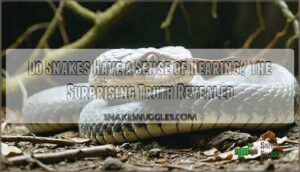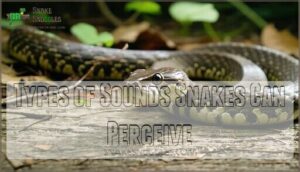This site is supported by our readers. We may earn a commission, at no cost to you, if you purchase through links.

They can’t hear your voice or most airborne sounds because they lack external ears.
Instead, snakes "hear" through bone conduction – vibrations travel through their jawbones and skull to their inner ear.
Think of it as feeling sound rather than hearing it traditionally.
They’re particularly good at detecting low-frequency vibrations from footsteps or prey movement through the ground.
This unique hearing system works alongside their other incredible senses to create a complete picture of their surroundings, revealing fascinating adaptations you’ve probably never considered.
Table Of Contents
- Key Takeaways
- Do Snakes Have a Sense of Hearing?
- Snake Hearing Mechanisms
- Types of Sounds Snakes Can Perceive
- Hearing Abilities of Snakes
- Significance of Hearing for Snakes
- Other Sensory Abilities of Snakes
- Can Snakes Hear Human Voices?
- The Effect of Sound on Snakes
- Frequently Asked Questions (FAQs)
- Can snakes hear you talk to them?
- Does a snake have a sense of hearing?
- Does sound keep snakes away?
- Can the snake hear the been?
- Do snakes react to sound?
- Are snakes hearing sensitive?
- Do snakes listen to humans?
- How do snakes react to music or specific frequencies?
- Can snakes be trained to respond to auditory cues?
- How does a snakes hearing change as it ages?
- Conclusion
Key Takeaways
- You’ll discover that snakes don’t have external ears, but they do hear through bone conduction – vibrations travel through their jawbones to their inner ear, allowing them to detect sounds between 80-600 Hz.
- You can actually talk to your snake and they’ll detect your voice since human speech falls within their hearing range, though they won’t understand what you’re saying.
- You’ll find that snakes primarily use their hearing to detect prey movement and avoid predators by sensing ground vibrations and low-frequency sounds rather than airborne noises.
- You should know that a snake’s hearing works as part of a complete sensory system alongside their exceptional smell, touch, temperature detection, and eyesight to help them survive in their environment.
Do Snakes Have a Sense of Hearing?
Snake Hearing isn’t a myth—these fascinating reptiles do possess hearing in snakes, though it works differently than you’d expect.
Unlike mammals, snake ear structure lacks external ears and eardrums. Instead, their snake auditory system relies on vibration detection through specialized bone conduction.
Snakes hear without ears, using their jawbones to detect vibrations through the ground.
Their jaw bones connect directly to inner ear structures, creating an efficient auditory system for sound perception.
This unique snake hearing ability allows them to detect ground vibrations and some airborne sounds within specific frequency ranges.
While their snakes sense of hearing may seem limited compared to humans, it’s perfectly adapted for their survival needs, helping them locate prey and avoid predators in their natural environment.
Snake Hearing Mechanisms
You’ll discover that snakes don’t hear the way you might expect, but they’ve evolved a fascinating system that works perfectly for their needs.
Their unique hearing mechanism relies on bone conduction and specialized inner ear structures that detect vibrations through their jawbones rather than traditional external ears.
Bone Conduction
You’re probably surprised to learn that snakes aren’t deaf at all – they use bone conduction for their unique auditory mechanism.
Snakes hear through their jawbones, not their ears—nature’s clever workaround for ground-dwelling hunters.
When sound waves hit the ground, their jawbone sensing system picks up these vibrations through specialized bone structure.
This snake hearing mechanism works differently than yours, relying on vibration detection rather than traditional ears.
Their skull and jaw bones conduct sound wave detection directly to the inner ear, creating an effective snake auditory system that helps them survive in their environment.
Inner Ear Structure
Understanding bone conduction sets the stage for exploring what’s inside a snake’s head.
Inner ear bones work together like a precision instrument, with the columella auris connecting directly to the jawbone.
The cochlear duct houses specialized hair cells that detect vibrations and convert them into electrical signals.
These signals travel through the auditory nerve to the brain.
Semicircular canals help with balance, while this entire auditory system operates without external ears, making snake auditory anatomy uniquely adapted for ground-based sound detection.
The unique structure of a snake’s hearing relies on snake ear anatomy to detect vibrations.
Hearing Range and Sensitivity
Snakes’ frequency response operates within a surprisingly narrow auditory limits range of 80-600 Hz, with some species reaching 1000 Hz. Their hearing capacity focuses on low-frequency sounds that matter most for survival.
Unlike humans who hear 20-20,000 Hz, snake hearing range prioritizes vibrations over airborne sounds. This specialized sensory perception creates distinct sound threshold levels.
- Snake sound detection works best between 80-160 Hz frequencies
- Auditory perception varies substantially among different snake species
- Reptile hearing loss occurs naturally above 600 Hz in most species
- Snake hearing sensitivity depends on environmental temperature and ground contact
The ability to detect vibrations is vital for understanding snake hearing mechanisms that facilitate their survival in various environments.
Types of Sounds Snakes Can Perceive
You’ll discover that snakes can’t hear the high-pitched sounds that make your dog’s ears perk up, but they’re surprisingly good at detecting low-frequency vibrations.
Their hearing range of 80-600 Hz means they pick up deep rumbles and ground vibrations rather than sharp noises, helping them identify whether an approaching sound signals dinner or danger.
High-pitched Sounds
Here’s why high-pitched sounds present unique challenges for snake auditory perception. Your average snake’s hearing mechanisms struggle with frequencies above their auditory threshold of 600-1000 Hz.
Their frequency response creates distinct sonic boundaries that limit pitch perception. Unlike mammals, snakes can’t detect sharp whistles or bird calls effectively.
These sound limits mean their snake hearing range focuses on lower frequencies for snake sound detection. However, some species show surprising snake sound recognition abilities within their narrow auditory perception window, adapting their survival strategies accordingly.
Low-pitched Sounds
Low-frequency sounds represent the sweet spot for snake hearing.
Your typical snake’s auditory range peaks between 80-160 Hz, making them masters of vibration detection.
These reptiles excel at picking up sound waves from footsteps, prey movement, and ground disturbances.
Their hearing mechanisms evolved specifically for low frequency detection, giving them a tactical advantage in their environment.
While their hearing limits exclude higher pitches, this specialized reptile auditory system perfectly suits their ground-dwelling lifestyle and hunting needs.
Differentiating Prey and Predator Sounds
Frequently, snakes demonstrate remarkable auditory discrimination when distinguishing between different sound sources in their environment.
Their specialized auditory system processes vibrational cues to identify potential threats versus prey opportunities. This snake hearing ability combines sound detection with vibration detection for enhanced survival strategies.
Snakes also utilize thermal vision systems to detect prey in their surroundings.
- Frequency analysis: Their auditory system differentiates between high-frequency prey movements and low-frequency predator approaches
- Intensity assessment: Sound detection mechanisms gauge proximity and threat level through vibrational amplitude
- Directional processing: Prey localization occurs through precise vibration detection, enabling effective predator avoidance responses
Hearing Abilities of Snakes
You’ll discover that snakes can indeed detect both vibrations through the ground and changes in air pressure, though their abilities vary substantially between species and environments.
Different snake species show remarkable differences in their hearing sensitivity, with some detecting sounds up to 1000 Hz while others remain limited to the typical 80-600 Hz range, which affects their ability to detect vibrations.
Detection of Vibrations and Air Pressure Changes
Unlike mammals who rely on external ears, you’ll find that snakes have developed an extraordinary auditory system that works through bone conduction.
Their vibration detection abilities let them sense ground tremors and air pressure changes through their jawbones.
This somatic hearing mechanism picks up sound waves within their specific frequency range of 80-600 Hz.
When prey moves nearby, the resulting vibrations travel through the snake’s body to specialized inner ear structures.
This sound wave detection system proves remarkably effective for survival, allowing snakes to monitor their environment continuously through their unique auditory mechanism.
Variation Among Species and Environment
Snake hearing range varies dramatically across species and environments. Different snake species have evolved unique auditory variation patterns that match their ecological niche requirements. Environmental factors shape these adaptations substantially.
Consider how species adaptation works in practice:
- Woma pythons actively move toward sounds while hunting prey
- Death adders retreat from acoustic stimuli as defensive behavior
- Sea snakes detect underwater frequencies that terrestrial species can’t perceive
- Arboreal species develop enhanced sensitivity for tree-dwelling prey detection
- Desert dwellers rely more heavily on ground vibration sensing
Snake ecology demonstrates that habitat drives hearing evolution. Marine environments require different reptile auditory perception than forest floors. Ground-dwelling species show stronger substrate vibration sensitivity compared to tree-climbing cousins. Temperature also affects performance since cold-blooded physiology impacts snake sensory organs function.
While snake communication methods remain limited, each species has developed just enough auditory capability to survive in their specific environment without competing with mammals’ sophisticated hearing systems.
Significance of Hearing for Snakes
Now that you understand how snakes detect sound, you’ll discover why this ability matters for their daily survival.
Their hearing serves as a backup system that works alongside their other senses to help them navigate a world full of threats and opportunities.
Prey Detection
Vibration Detection gives snakes a hunting advantage you wouldn’t expect.
Their snake hearing range picks up ground tremors from moving prey, creating detailed sound localization maps.
This prey tracking system works like nature’s radar – snake vibration sensitivity detects footsteps, heartbeats, and breathing patterns.
These sensory cues guide hunt strategies, helping snakes strike with pinpoint accuracy even in total darkness.
The ability to detect vibrations is similar to using advanced vibration sensors to monitor seismic activity.
Predator Detection
Hearing serves as your snake’s early warning system against predators.
When larger animals approach, ground vibrations travel faster than the threat itself, giving snakes precious seconds to escape. Their vibration detection capabilities work like nature’s burglar alarm, alerting them to incoming danger.
- Threat awareness helps snakes distinguish between harmless movements and genuine predator approaches
- Attack evasion relies on detecting low-frequency sounds from approaching mammals and birds
- Survival tactics include using sound localization to determine escape routes when predators strike
Navigational Aid
Beyond predator awareness, you can observe how snakes navigate their world through vibration detection and sound localization.
Their spatial awareness develops through environmental cues that create mental terrain mapping. Sound waves help them identify safe pathways and locate shelter sites.
| Navigation Function | Hearing Mechanism |
|---|---|
| Path Selection | Ground vibration analysis |
| Obstacle Detection | Sound wave reflection |
| Shelter Location | Environmental sound patterns |
| Territory Mapping | Vibration frequency recognition |
This sensory perception allows snakes to move confidently through complex environments, using their animal hearing range to supplement visual information for successful navigation.
Combined Use With Other Senses
These remarkable reptiles excel at sensory integration, weaving hearing with smell, touch, and vision into seamless environmental awareness.
Their multimodal perception creates a sophisticated detection system where each sense amplifies the others.
Snake cognition demonstrates adaptive behavior through this sensory teamwork, making them incredibly effective hunters and survivors.
- Your snake’s "sixth sense" – multiple sensory systems working as one unified detection network
- Nature’s early warning system – combined senses that can detect threats before you’d even notice them
- The ultimate survival toolkit – hearing, smell, and vibration sensing creating an unbeatable combination
- Sensory superpowers – what seems like simple hearing is actually complex environmental processing
- Built-in backup systems – if one sense fails, others compensate to keep snakes safe and effective
Other Sensory Abilities of Snakes
While you now understand how snakes hear through their unique bone conduction system, these reptiles rely on several other remarkable senses that work together to help them survive.
Their hearing abilities represent just one piece of a sophisticated sensory toolkit that includes exceptional smell detection, precise touch sensitivity, infrared temperature sensing, and surprisingly good eyesight.
Their sensory capabilities are crucial for survival, and include infrared temperature sensing.
Smell
Snakes possess an extraordinary olfactory system that puts hearing to shame.
Their forked tongues collect airborne chemical signals and ground scent marking particles, delivering them to specialized smell receptors in the Jacobson’s organ.
This chemosensory superpower enables precise pheromone detection and snake odor detection, allowing them to track prey trails, identify mates, and recognize territorial boundaries with remarkable accuracy.
Touch
While smell helps snakes detect prey from afar, their touch sensitivity reveals an entirely different world of information.
Through Vibration Detection, snakes transform their entire body into a living sensor network. Their Scale Texture and specialized Skin Sensitivity work together to perceive the slightest environmental changes.
Tactile Perception operates through multiple mechanisms:
- Ground vibrations travel through their belly scales like seismic waves
- Jawbone positioning amplifies vibrations for enhanced detection
- Jaw Movement helps triangulate vibration sources and distances
- Somatic hearing combines touch and vibration into spatial awareness
- Snake jawbone function converts ground tremors into navigational data
This remarkable system lets snakes "feel" approaching footsteps from remarkable distances, basically turning the ground into their personal communication network.
Temperature Detection
While touch helps snakes navigate their world, thermal sensing proves equally essential for survival.
You’ll find heat detection fascinating – snakes use specialized heat pits containing infrared radiation sensors to locate warm-blooded prey in complete darkness.
As ectothermic creatures, they can’t regulate body temperature internally, making environmental temperature awareness critical.
This thermoregulation system helps them find suitable basking spots and avoid dangerous cold adaptation situations that could prove fatal.
Eyesight
Understanding Visual Acuity reveals how snake vision differs from yours.
While Color Vision remains limited, their Eye Structure adapts perfectly for survival.
Snake species show varying sight capabilities, with some detecting movement better than details.
Their Field Depth perception helps track prey, though Peripheral Sight stays restricted.
Eyesight complements other snake senses rather than dominating them.
Can Snakes Hear Human Voices?
You might wonder if your pet snake can actually hear you talking to it.
Research shows that snakes can detect human voices, which typically fall within their hearing range of 80-600 Hz, though their perception sounds more muffled compared to how we hear.
Snake’s Ability to Detect Human Speech
Looking beyond their other remarkable senses, humans naturally wonder about Speech Perception in snakes. Your pet snake won’t understand your words, but it’s surprisingly tuned in to your Human Voice through specialized snake hearing mechanisms.
When you speak, your voice creates Sound Waves that typically range from 100-250 Hz – frequencies that fall within snake hearing capabilities. However, their Vocal Detection works differently than ours. Snakes process sound through auditory nerve fibers connected to their jawbones, making their sound wave detection quite unique.
Snakes are able to detect low frequency sounds through this method. Here’s what happens when you talk to your snake:
- Your voice vibrations travel through air and ground
- Snake hearing picks up lower frequencies from your speech
- Their jawbone conducts these vibrations to inner ear structures
- Auditory Limits mean they miss higher-pitched vocal elements
While snakes can detect human voice frequency ranges, they’re not processing language like your dog might. Think of it as sensing your presence rather than understanding your conversation. This unique ability allows them to be aware of their surroundings in a way that is distinct from human perception.
Interaction With Human-generated Sounds
Snakes detect your voice and other human-generated sounds through vibrational awareness, though they can’t comprehend what you’re saying.
Their sound perception abilities allow them to respond to the hearing frequencies within their 80-600 Hz range, making human voice detection possible since we speak around 250 Hz.
When you interact with snakes, expect these noise response behaviors:
- Retreating quickly when they detect sudden loud sounds or unexpected auditory stimulation
- Freezing in place to assess potential threats from unfamiliar sound wave detection patterns
- Becoming hyperalert when consistent vibrations suggest nearby movement or activity
- Avoiding areas where frequent human noise creates ongoing environmental disturbance.
Your presence affects their natural behaviors substantially.
Snakes often abandon prime hunting spots when human-generated sounds become too frequent.
While their snake hearing abilities can’t decode speech meaning, their snake response to sound helps them evaluate whether you’re friend or foe based on volume and movement patterns.
The Effect of Sound on Snakes
You’ve probably noticed how snakes react when you walk nearby or start your lawnmower – they don’t just sense ground vibrations, they also respond to airborne sounds in ways that can surprise you.
Understanding how different environmental noises affect snake behavior helps explain why some sounds make them freeze while others send them slithering away quickly, which is an important aspect of their behavior related to airborne sounds.
Response to Environmental Noises
When environmental sounds hit a snake’s world, their bodies become living antennas for noise detection.
Sound waves travel through air and ground, triggering distinct vibration responses that snakes can’t ignore.
Their unique auditory perception system picks up environmental cues ranging from 80-600 Hz, making them surprisingly sensitive to nearby activities.
A rustling leaf might signal approaching prey, while heavy footsteps warn of danger.
Snake hearing works like nature’s early warning system—their jawbones detect vibrations and transmit signals to specialized inner ear structures.
This hearing frequencies range helps them survive in environments where split-second decisions matter.
Without traditional snake ears, they’ve mastered sound wave detection through bone conduction.
Every vibration tells a story, whether it’s a mouse scurrying nearby or a predator stalking through underbrush.
Their response to sound isn’t just passive listening—it’s active environmental monitoring that keeps them alive in wild habitats.
Snakes utilize their senses, including heat sensing pits, to detect and respond to potential threats in their environment.
Behavioral Impact of Sound Stimuli
Research reveals fascinating insights about how Sound Response triggers distinct behavioral changes in snakes.
When exposed to acoustic stimuli, you’ll notice Auditory Reflex patterns emerge immediately.
Taipans display heightened defensive behaviors, while other species show increased tongue flicking and visual scanning.
Vibrational Cues prompt either retreat or investigative movement, depending on the threat level.
Sounds above 90 decibels trigger aversive reactions, demonstrating clear Noise Tolerance thresholds.
Sonic Awareness varies between species – vipers hiss defensively while pythons may freeze temporarily.
These responses indicate snake hearing capabilities beyond simple vibrations detection.
Sound waves influence collective movement patterns and habitat selection.
Understanding these hearing senses helps explain how snake auditory structures process environmental information for survival decisions.
The study of snake hearing also involves the use of snake hearing aids to improve their auditory perception.
Frequently Asked Questions (FAQs)
Can snakes hear you talk to them?
Like tuning into a distant radio station, your voice travels through their world at frequencies they can detect.
Yes, snakes can hear you talk—their hearing range of 80-600 Hz captures human speech perfectly well through specialized jaw bones.
Does a snake have a sense of hearing?
Yes, you can rest assured that snakes do have hearing abilities. They detect sounds through vibrations transmitted via their jawbones to inner ear structures, perceiving frequencies between 80-600 Hz effectively.
Does sound keep snakes away?
Sound doesn’t reliably keep snakes away.
Since snakes hear only 80-600 Hz frequencies, most ultrasonic devices won’t work.
They’re more likely to respond to vibrations than airborne sounds, making noise-based deterrents largely ineffective.
Can the snake hear the been?
Snakes can definitely hear bees! Their hearing range of 80-600 Hz easily picks up a bee’s buzzing, which typically falls around 230-250 Hz.
You’ll find that snakes detect these vibrations through their specialized jawbone system, making them quite aware of buzzing insects nearby.
Do snakes react to sound?
Music to your ears – snakes absolutely react to sound.
They’ll respond to vibrations and airborne sounds between 80-600 Hz, including human voices, by moving, freezing, or changing behavior patterns when detecting these auditory stimuli, which can be considered auditory stimuli and involve human voices.
Are snakes hearing sensitive?
While not razor-sharp listeners, you’ll find snakes can detect sounds between 80-600 Hz through their jaw bones. They’re most sensitive to low-frequency vibrations, making their hearing adequate for survival needs.
Do snakes listen to humans?
Like tuning into a distant radio station, you’ll find snakes can indeed hear your voice.
They detect sounds between 80-600 Hz, perfectly capturing human speech frequencies around 250 Hz through vibrations in their jawbones.
How do snakes react to music or specific frequencies?
You’ll find snakes respond differently to various frequencies based on their limited hearing range of 80-600 Hz.
Lower frequencies around 100-250 Hz may trigger movement or defensive behaviors, while higher-pitched music goes unnoticed, and it’s essential to understand that snakes have a unique response to different frequencies.
Can snakes be trained to respond to auditory cues?
Yes, you can train snakes to respond to specific sounds within their 80-600 Hz hearing range.
Since they detect vibrations through their jawbones, consistent auditory cues paired with rewards can create conditioned responses.
Though their limited hearing makes visual or tactile training more effective.
How does a snakes hearing change as it ages?
Time’s steady march affects your snake’s hearing differently than you’d expect – their vibration-sensing abilities actually remain remarkably stable throughout life, unlike mammals whose hearing typically declines with age.
Conclusion
Surprisingly enough, snakes do have a sense of hearing that’s perfectly suited to their ground-dwelling lifestyle.
While they can’t detect your conversations or music through traditional airborne sound waves, their bone conduction system expertly picks up vibrations that matter most for survival.
This specialized hearing combines with their other remarkable senses to create a thorough detection network.
Understanding how snakes perceive their acoustic world helps us appreciate these fascinating reptiles and their unique evolutionary adaptations.
- https://www.animalwised.com/can-snakes-hear-3519.html
- https://www.thesprucepets.com/are-snakes-bothered-by-loud-noises-1239469
- https://journals.biologists.com/jeb/article/215/2/ii/11057/SNAKES-HEAR-THROUGH-SKULL-VIBRATION
- https://pmc.ncbi.nlm.nih.gov/articles/PMC9928108/
- https://www.discovermagazine.com/planet-earth/yes-snakes-can-hear-sound
















